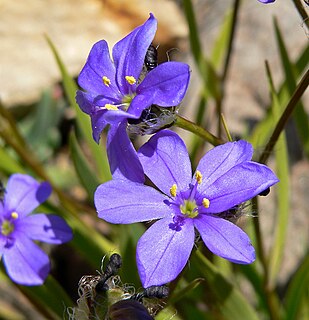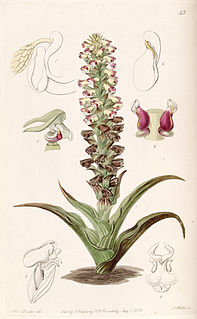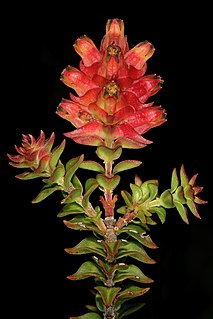
The Solanales are an order of flowering plants, included in the asterid group of dicotyledons. Some older sources used the name Polemoniales for this order.

Convolvulaceae, known commonly as the bindweed or morning glory family, is a family of about 60 genera and more than 1,650 species of mostly herbaceous vines, but also trees, shrubs and herbs, and also including the sweet potato and a few other food tubers.

Campanula is one of several genera of flowering plants in the family Campanulaceae with the common name bellflower. It takes both its common and its scientific name from its bell-shaped flowers—campanula is Latin for "little bell". In Russian it is called kolokolchik.

Euclea, from the Greek eukleia meaning "glory and fame", denotes a group of flowering plants in the Ebenaceae or ebony family. They were described as a genus by Linnaeus in 1774. The genus includes evergreen trees and shrubs, native to Africa, the Comoro Islands and Arabia. Several species are used for timber, producing a hard, dark heartwood timber similar to ebony.

Ocimum is a genus of aromatic annual and perennial herbs and shrubs in the family Lamiaceae, native to the tropical and warm temperate regions of all 6 inhabited continents, with the greatest number of species in Africa. It is the genus of basil and the name is from the Ancient Greek word for basil, ὤκιμον (ṓkimon). Its best known species are the cooking herb cooking basil, O. basilicum and the medicinal herb tulsi, O. tenuiflorum.
Adenocline is a genus of plants, under the family Euphorbiaceae first described as a genus in 1843. It is native to southern Africa.
- Adenocline acuta(Thunb.) Baill. - Malawi, Zimbabwe, Cape Province
- Adenocline paucifloraTurcz. - KwaZulu-Natal, Cape Province
- Adenocline violifolia(Kunze) Prain - Cape Province

Ehrharta is a genus of plants in the grass family.

Mesembryanthemum is a genus of flowering plants in the family Aizoaceae; like many members of this family, it is characterized by long-lasting flower heads. Flowers of Mesembryanthemum protect their gametes from night-time dews or frosts but open in sunlight. There is an obvious evolutionary advantage to doing this; where sun, dew, frost, wind or predators are likely to damage exposed reproductive organs, closing may be advantageous during times when flowers are unlikely to attract pollinators. It is indigenous to southern Africa.

Protea laurifolia, also known as the grey-leaf sugarbush, is a shrub from South Africa. It is native to the Cape Provinces of South Africa.

Aristea is a genus of evergreen, perennial and rhizomatous species of flowering plants in the family Iridaceae, first described in 1789. The genus is distributed in tropical and southern Africa, as well as Madagascar. The genus name is derived from the Greek word arista, meaning "awn".

Corycium is a genus of terrestrial orchids comprising some 14 species in Eastern and Southern Africa including 10 species native to the fynbos. In South Africa they are called monkshood orchids.

Oncosiphon is a small genus of flowering plants in the daisy family (Asteraceae). All known species are native to southern Africa.
Ipomoea gracilis is a plant in the bindweed family, Convolvulaceae. It is found in northern and north-eastern Australia.

Liparia is a genus of flowering plants in the legume family, Fabaceae. It belongs to the subfamily Faboideae.
Willdenowia is a small genus of flowering plants in the family Restionaceae described as a genus in 1790. The entire genus is endemic to the fynbos of the Western Cape Province of South Africa.

Hermannia is a genus of flowering plants in the mallow family, Malvaceae. It comprises at least 65 species with many more species as yet unresolved.

Maureen Elizabeth Church, was a Welsh-born botanist and skilled, self-trained botanical illustrator. Her preferred technique was that of line drawings and her work is in the permanent collections of the Forest Herbarium in Oxford, the East African Herbarium in Nairobi, the Herbarium at Kew, and the University of Edinburgh.

Polygala virgata is a species of flowering plant in the milkwort family (Polygalaceae). It is native to South Africa and Botswana.
Senecio arenarius is a species of flowering plant in the family Asteraceae. It is native to South Africa, Namibia, and Botswana.

Penaea is a genus of flowering plants in the family Penaeaceae, found in southern South Africa. They have an unusual type of embryo sac development; after two rounds of mitosis, four nuclei are formed at each pole, leading to a mature embryo sac containing four polar groups each with three cells. When found in other taxa, these embryo sacs are termed Penaea-type.
















